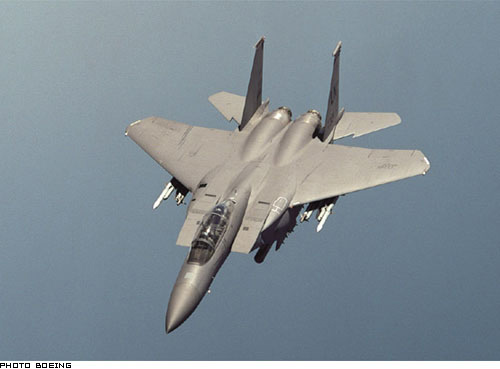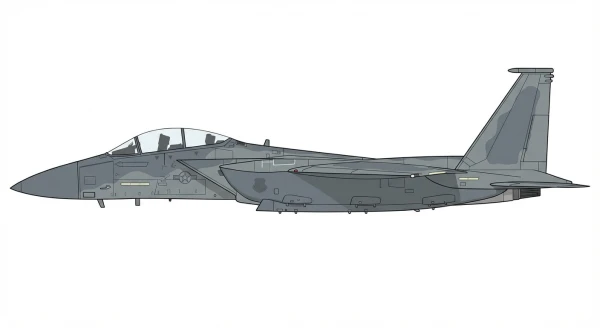F-15E Strike Eagle
Summary
| Category | Combat Aircraft |
| Origin country | 🇺🇸 United States |
| Manufacturer | McDonnell Douglas |
| First flight | 11 December 1986 |
| Year introduced | 1986 |
| Number produced | 525 units |
| Average unit price | $31 million |
Description
The F-15E Strike Eagle is an American all-weather multirole strike fighter, derived from the McDonnell Douglas F-15 Eagle. The F-15E was developed to replace the F-111 Aardvark in the United States Air Force's inventory. It was designed in the 1980s with the primary role of long-range, high-speed interdiction without relying on escort or electronic-warfare aircraft. The aircraft was produced by McDonnell Douglas, which later merged with Boeing.
It is an evolution of the F-15 air superiority fighter, adapted to perform ground-attack missions while maintaining its air-to-air capabilities. The F-15E is distinguished from earlier variants by its darker camouflage and conformal fuel tanks mounted along the engine intakes.
The F-15E made its first flight in December 1986, and it was deployed for the first time in 1989 during Operation Desert Storm.
The F-15E Strike Eagle features a twin-engine, dual-seat design, with the pilot sitting in the front and the weapons systems officer in the rear. One of its key distinguishing features compared to its predecessor, the F-15, is the presence of conformal fuel tanks (CFTs) fitted along the sides of the engine intakes. These tanks allow for increased fuel storage, thereby extending the aircraft's range without taking up hardpoints that could be used for munitions.
The aircraft is built for versatility, capable of carrying a wide array of air-to-air and air-to-ground munitions. Its avionics suite is designed for multirole functionality, featuring radar systems capable of ground mapping as well as air target identification, and an array of sensors and targeting pods that can be fitted for specific mission requirements.
Structurally, the F-15E is made largely of various metals, including titanium and aluminum alloys, which give it both strength and a relatively low weight. It has a strong airframe that allows for high-G maneuvers, which is crucial for both air-to-air combat and low-level ground attack runs.
In terms of aerodynamics, the F-15E inherits the successful design elements of the original F-15, such as the forward-swept wing design that enables high-speed performance and agility. Its powerful twin F100-PW-220 or F100-PW-229 turbofan engines enable the aircraft to reach speeds up to Mach 2.5, and give it a very high thrust-to-weight ratio, making it one of the most powerful and maneuverable fighters in the world.
The aircraft also features advanced electronic warfare and countermeasures systems, including radar warning receivers, chaff and flare dispensers, and jamming capabilities, offering it a high degree of survivability in hostile environments.
Armament
The F-15E Strike Eagle is equipped with a wide array of weapons for both air-to-air and air-to-ground missions, making it a true multirole fighter.
For air-to-air combat, the aircraft is typically armed with AIM-120 AMRAAM (Advanced Medium-Range Air-to-Air Missile) and AIM-9 Sidewinder missiles. The AIM-120 is a radar-guided missile capable of beyond-visual-range engagements, while the AIM-9 Sidewinder is an infrared-guided missile used for close-range combat. The F-15E also has an internally mounted M61A1 Vulcan 20mm six-barrel rotary cannon with about 500 rounds of ammunition for dogfighting scenarios or strafing ground targets.
For air-to-ground missions, the F-15E can carry a diverse range of munitions. Precision-guided munitions include the GBU-10, GBU-12, and GBU-24 Paveway laser-guided bombs, as well as the more modern JDAM (Joint Direct Attack Munition) and SDB (Small Diameter Bomb). It can also carry AGM-65 Maverick air-to-ground tactical missiles and AGM-130 powered bombs for engaging more hardened targets.
The aircraft's hardpoints, which are the external mounting points for weapons, are another testament to its versatility. The F-15E has multiple hardpoints under its wings and fuselage, allowing it to carry a mix of air-to-air and air-to-ground ordnance simultaneously. This makes it capable of executing complex missions that require both offensive and defensive capabilities.
It is also worth noting that the F-15E is equipped with advanced targeting pods like the LANTIRN (Low Altitude Navigation and Targeting Infrared for Night), Sniper XR, or Litening, which provide enhanced targeting capabilities in all weather conditions, day or night. These targeting pods offer improved navigation, target identification, and laser designation for precision-guided munitions.
Operational history
Operation Desert Storm (1991) marked the F-15E's first combat operations. It played a crucial role in the air campaign against Iraq, performing deep strikes against high-value targets, airfield attacks, and interdiction missions. It was also involved in the infamous "Package Q" strike against a heavily defended target in downtown Baghdad, which marked one of the largest air battles since World War II.
The F-15E continued to see action in the 1990s over the Balkans during Operations Deliberate Force and Allied Force. It was responsible for taking out air defenses, artillery, and other ground targets to enforce UN resolutions against the Federal Republic of Yugoslavia.
In the 2000s, the aircraft was extensively used in Operations Enduring Freedom (Afghanistan) and Iraqi Freedom. Its ability to deliver precision-guided munitions made it valuable for close air support missions and in taking out insurgent strongholds or high-value targets. The F-15E also saw operations over Libya in 2011 as part of Operation Odyssey Dawn, enforcing the UN-mandated no-fly zone and conducting strikes against Libyan government forces.
The F-15E has also been active in the ongoing conflict against ISIS, participating in Operation Inherent Resolve since 2014. It has been used for both close air support missions for allied ground troops and for taking out strategic targets like weapon caches and command centers.
Variants
- F-15E Block I: This was the initial production version of the F-15E, featuring the core attributes of the Strike Eagle, such as conformal fuel tanks, a strengthened airframe, and the capacity for ground-attack munitions.
- F-15E Block II: An upgraded version with improved avionics and systems integration. This version featured advanced radar systems and targeting pods, as well as compatibility with newer precision-guided munitions.
- F-15E+ (or Advanced F-15E): These versions are equipped with more advanced avionics, structural improvements, and increased payload capacities. They also often incorporate modern electronic warfare and countermeasures systems.
- F-15SA (Saudi Advanced): A specialized variant tailored for the Royal Saudi Air Force. The F-15SA features the latest advancements in radar technology, electronic warfare, and weapon systems, including the capacity to carry more advanced missile systems like the AIM-120D AMRAAM.
- F-15SG: Customized for the Singapore Air Force, the F-15SG is similar to the F-15SA in terms of advanced avionics and systems but has some differences tailored to Singapore's operational needs.
- F-15K Slam Eagle: Developed for the South Korean Air Force, the F-15K is equipped with certain unique systems, such as an AAS-42 Infrared Search and Track system and the capability to carry a reconnaissance pod.
- F-15QA (Qatar Advanced): This is the most advanced F-15 variant to date, designed for the Qatar Emiri Air Force. It features even more advanced avionics, a new electronic warfare suite, and improved cockpit systems compared to previous versions.
- F-15EX: A U.S. version that represents the latest iteration of the aircraft, designed to replace ageing F-15C/D models in the U.S. Air Force. It features state-of-the-art avionics, including a fully digital cockpit, and the latest versions of radar and electronic warfare systems. It also has the capability to carry hypersonic weapons.
Technical specifications
| Version: F-15E Strike Eagle | |
|---|---|
| Crew | 1 pilot + 1 WSO |
| Maximum speed | 2655 km/h (1650 mph) |
| Wing area | 56 m² (602.8 sqft) |
| Wingspan | 13.1 m (42.8 ft) |
| Height | 5.6 m (18.5 ft) |
| Length | 19.4 m (63.7 ft) |
| Service ceiling | 18,288 m (60,000 ft) |
| Empty weight | 14,379 kg (31,700 lbs) |
| Max. takeoff weight | 36,741 kg (81,000 lbs) |
| Climb rate | 254.0 m/s (833.3 ft/s) |
| Powerplant | 2 x turbojets Pratt & Whitney F100-PW-229 delivering 13154 kgf each |
| Ejection seat | McDonnell Douglas ACES II |
Current operating countries
| Country | Units | ||
|---|---|---|---|

|
United States | 368 (+100) | |

|
Saudi Arabia | 232 | |

|
Japan | 199 | |

|
Israel | 87 (+25) | |

|
South Korea | 59 | |

|
Singapore | 40 | |

|
Qatar | 37 (+35) | |

|
Indonesia | 0 (+24) | |
All operators
Armament
Missiles payload:
- Air-to-Surface AGM-65 Maverick
- Air-to-Surface AGM-84 Harpoon
- Air-to-Surface AGM-130
- Air-to-Surface AGM-158 JASSM
- Air-to-Air Medium-Range AIM-7 Sparrow
- Air-to-Air Medium-Range AIM-120 AMRAAM
- Air-to-Surface Raytheon AGM-154 JSOW
- Air-to-Air Short-Range Raytheon AIM-9 Sidewinder
Bombs payload:
- Cluster Aerojet CBU-87/B CEM
- Thermonuclear B61
- Guided Boeing GBU-31/B JDAM
- Guided Boeing GBU-38/B JDAM
- Guided Boeing GBU-39/B SDB
- Guided Boeing GBU-54
- Cluster CBU-89/B Gator
- Cluster CBU-170
- Guided GBU-72/B
- Cluster Lockheed-Martin CBU-103/B WCMD
- Cluster Lockheed-Martin CBU-104/B WCMD
- Low-Drag Mk 82
- Low-Drag Mk 84
- Laser-Guided Raytheon GBU-10 Paveway II
- Laser-Guided Raytheon GBU-12
- Laser-Guided Raytheon GBU-51/B Paveway II
- Guided Rockwell GBU-15(V)1/B MGWS
- Cluster Textron CBU-97/B SFW
- Cluster Textron CBU-105/B WCMD


